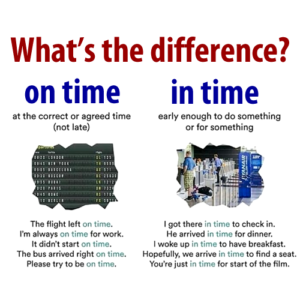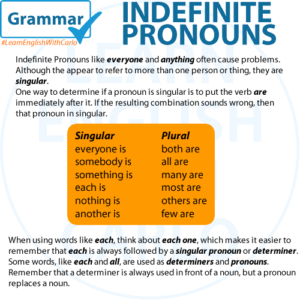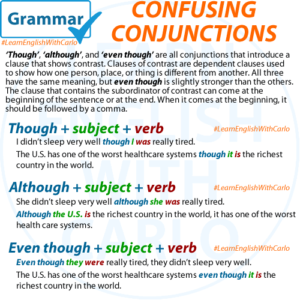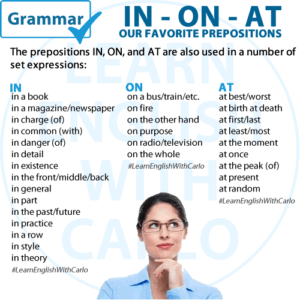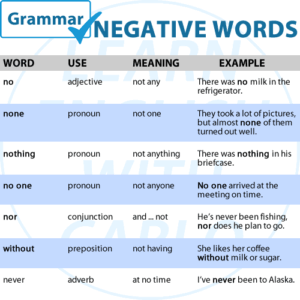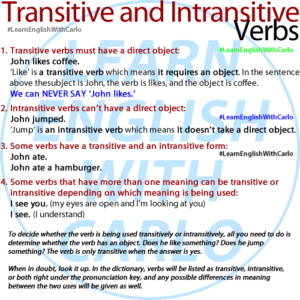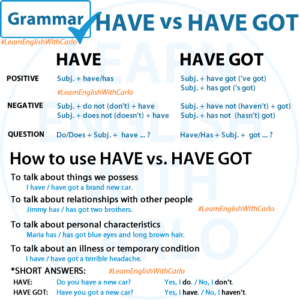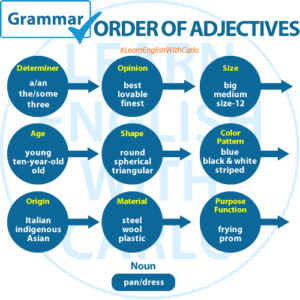Many people confuse these two expressions. And while they are similar, there is a very important difference. ON time – This referrs to when you have an appointment or scheduled time to be somewhere or do something. The meeting starts at 2 pm. I have to be on time. (If I’m late something bad will …
Category: GRAMMAR
Permanent link to this article: https://englishyourway.com.br/whats-the-difference-in-time-vs-on-time/
Nov 12
GRAMMAR – Indefinite Pronouns
GRAMMAR – Indefinite Pronouns Indefinite Pronouns like everyone and anything often cause problems. Although the appear to refer to more than one person or thing, they are SINGULAR. One way to determine if a pronoun is singular is to put the verb are immediately after it. If the resulting combination sounds wrong, then that pronoun …
Permanent link to this article: https://englishyourway.com.br/grammar-indefinite-pronouns/
Nov 09
Understanding Conjunctions for Contrast
Though, Although, and Even Though Conjunctions play a crucial role in connecting ideas within sentences, and when it comes to expressing contrast, three common ones stand out: “though,” “although,” and “even though.” Let’s delve deeper into how these conjunctions function and how they can elevate your writing! 1. Though 2. Although 3. Even Though Placement …
Permanent link to this article: https://englishyourway.com.br/understanding-conjunctions-for-contrast/
Nov 04
GRAMMAR – IN – ON – AT
The prepositions IN, ON, and AT are also used in a number of set expressions:in a book/magazine newspaperin charge (of)in common (with)in danger (of)in detailin existencein the front/middle/backin generalin partin the past/futurein practicein a rowin stylein theoryon a bus/train/etc.on fireon the other handon purposeon radio/televisionon the wholeat best/worstat birth at deathat first/lastat least/mostat the momentat …
Permanent link to this article: https://englishyourway.com.br/grammar-in-on-at/
Oct 29
GRAMMAR – Interrogative Pronouns (question words)
An Interrogative Pronoun (question word) is a word we use in an information question (as opposed to a yes/no questions). The most common question words in English are: WHO is only used when referring to people, when we want to know the person. WHERE is used when asking about a place or location, when we want to know the …
Permanent link to this article: https://englishyourway.com.br/grammar-interrogative-pronouns-question-words/
Oct 29
Negative Words in English
🚫 No, none, nothing, no one, nor, without, never…So many ways to say no! 😅 At first glance, these little words seem almost the same — they all express the idea of negation or absence. But in English, each one has its own special job in a sentence. Understanding how to use them correctly can …
Permanent link to this article: https://englishyourway.com.br/negative-words-in-english-grammar/
Oct 27
Transitive and Intransitive Verbs Explained
Verbs are the heart of every sentence. They tell us what’s happening — what the subject does or is. But did you know that some verbs need an object, while others stand alone? That’s where transitive and intransitive verbs come in. Understanding the difference between them helps you build clear, grammatically correct sentences — and …
Permanent link to this article: https://englishyourway.com.br/transitive-and-intransitive-verbs-in-english-grammar/
Oct 26
HAVE & HAVE GOT
When we talk about possession, relationships, illnesses, or characteristics, English gives us two ways to express the same idea:👉 HAVE and HAVE GOT Both mean the same thing, but they’re used slightly differently in everyday English. 🧩 1. Meaning and Usage Both HAVE and HAVE GOT are used to talk about things we own, relationships, …
Permanent link to this article: https://englishyourway.com.br/have-vs-have-got-in-english-grammar/
Oct 25
GRAMMAR – Prepositions of Time
DURING, UNTIL, SINCE, and FOR Prepositions can sometimes be tricky to use correctly, especially when they refer to time. Let’s explore the nuances of DURING, UNTIL, FOR, and SINCE, along with deeper explanations and examples to make their usage clearer. DURING Definition: Refers to a specific period of time when something happens, or indicates that …
Permanent link to this article: https://englishyourway.com.br/prepositions-during-until-for-since/
Oct 24
GRAMMAR – Order of Adjectives
In English, when multiple adjectives are used to describe a noun, they typically follow a specific order. This order helps maintain clarity and natural-sounding language. The general order of adjectives is as follows: Here’s an example sentence using multiple adjectives in their correct order: “The beautiful small old wooden Italian music box.” In this sentence:“The” …
Permanent link to this article: https://englishyourway.com.br/grammar-order-of-adjectives/

